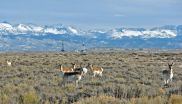(Press-News.org) MANHATTAN — Two Kansas State University biologists are studying streams to prevent tallgrass prairies from turning into shrublands and forests.
By looking at 25 years of data on the Konza Prairie Biological Station, Allison Veach, doctoral student in biology, Muncie, Indiana, and Walter Dodds, university distinguished professor of biology, are researching grassland streams and the expansion of nearby woody vegetation, such as trees and shrubs. They have found that burn intervals may predict the rate of woody vegetation expansion along streams.
Their latest research appears in the peer-reviewed journal PLOS ONE in an article "Fire and Grazing Influences on Rates of Riparian Woody Plant Expansion along Grassland Streams."
Grasslands in North America and across the globe are rapidly disappearing, Veach said, and woody plants are expanding and converting grasslands into forest ecosystems. This change in environment can affect stream hydrology and biogeochemistry, said Dodds, who has studied streams and watersheds on the Konza prairie for more than 20 years.
"This is an important issue regionally, because as trees expand into these grassland areas, people who are using grassland for cattle production have less grass for animals, too," Dodds said.
In their latest research, the biologists studied 25 years of aerial photography on Konza and observed the expansion of trees and shrubs in riparian areas, which include areas within 30 meters of streambeds. The researchers focused on three factors that affect grassland streams: burn intervals; grazers, such as bison; and the historical presence of woody vegetation.
Their analysis revealed an important finding: Burn intervals predicted the rate of woody vegetation expansion. Burning every one to two years slowed the growth of trees and shrubs, Veach said.
"Although we can reduce woody expansion by burning more frequently, we can't prevent it from occurring over time," Veach said. "Woody plant encroachment may not be prevented by fire alone."
The research shows the importance of burning to maintain the tallgrass prairie, Dodds said. While burning can help to slow the expansion of trees and shrubs, additional actions are need to maintain quickly disappearing grassland ecosystems.
"It's clear from this research that if you don't burn at all, these grassland streams basically are going to switch to forests and will not be grassland streams anymore," Dodds said.
Dodds and Veach also found that bison do not significantly affect woody vegetation expansion along streams. Previous Konza research has shown that bison do not spend significant time near stream areas, so they may not influence the growth of nearby trees and shrubs, Veach said.
Woody vegetation also may be expanding in grasslands because of more carbon dioxide in the atmosphere, Dodds said. Grasses and trees compete for carbon dioxide, and grasses are much better at conserving water and efficiently using carbon dioxide. As atmospheric carbon dioxide levels increase, it becomes easier for trees to gather carbon dioxide and gives them a growing advantage over grasses.
"The tallgrass prairie is almost nonexistent on the globe," Veach said. "In order for us to preserve tallgrass prairie, we need to look at woody encroachment because it has been an issue. Things like no fire or differences in climate change may allow woody plant species to competitively take over grasslands."
The biologists plan to continue studying water quality and quantity issues at Konza. Konza is an 8,600-acre tallgrass prairie ecological research site jointly owned by the university and The Nature Conservancy.
INFORMATION:
Veach and Dodds received research funding from the National Science Foundation's Konza Prairie Long-Term Ecological Research program and the Kansas Experimental Program to Stimulate Competitive Research. The research also involved Adam Skibbe at the University of Iowa.
Water research tackles growing grassland threat: Trees
2014-09-25
ELSE PRESS RELEASES FROM THIS DATE:
Pneumonia bacterium leaves tiny lesions in the heart, study finds
2014-09-25
SAN ANTONIO (Sept. 25, 2014) — The long-observed association between pneumonia and heart failure now has more physical evidence, thanks to research in the School of Medicine at The University of Texas Health Science Center at San Antonio.
The researchers found proof that Streptococcus pneumoniae, the leading cause of community-acquired pneumonia, actually physically damages the heart. The bacterium leaves tiny lesions that researchers detected in mouse, rhesus macaque and human autopsy tissue samples.
"If you have had severe pneumonia, this finding suggests your heart ...
New study shows that yoga and meditation may help train the brain
2014-09-25
New research by biomedical engineers at the University of Minnesota shows that people who practice yoga and meditation long term can learn to control a computer with their minds faster and better than people with little or no yoga or meditation experience. The research could have major implications for treatments of people who are paralyzed or have neurodegenerative diseases.
The research is published online in TECHNOLOGY, a new scientific journal featuring cutting-edge new technologies in emerging fields of science and engineering.
In the study, researchers involved ...
Researchers uncover structure of enzyme that makes plant cellulose
2014-09-25
WEST LAFAYETTE, Ind. - Purdue researchers have discovered the structure of the enzyme that makes cellulose, a finding that could lead to easier ways of breaking down plant materials to make biofuels and other products and materials.
The research also provides the most detailed glimpse to date of the complicated process by which cellulose - the foundation of the plant cell wall and the most abundant organic compound on the planet - is produced.
"Despite the abundance of cellulose, the nitty-gritty of how it is made is still a mystery," said Nicholas Carpita, professor ...
IU-Regenstrief CHICA system improves developmental delay screening and surveillance
2014-09-25
INDIANAPOLIS -- Is my child lagging behind physically, mentally or emotionally? Should I be concerned? When should I ask our pediatrician about it? What can I do to help my child?
A new study from Indiana University School of Medicine and Regenstrief Institute researchers reports that a computerized clinical decision support system is helping parents answer such questions. The system, which they developed to automate pediatric care guidelines, significantly increased the number of children screened for developmental delay at 9, 18 and 30 months of age, as recommended ...
Study identifies gauntlet of obstacles facing migrating pronghorn in greater Yellowstone
2014-09-25
One of North America's last remaining long-distance land migrations, better known as the Path of the Pronghorn, is being threatened by a mosaic of natural gas field development, highway traffic, and fencing in the upper Green River Basin, according to the Wildlife Conservation Society. WCS scientists used a model traditionally applied to identify resource related stopovers for migrating animals in order to identify impediments to migration of pronghorn.
The long-distance travels of the fleet-footed pronghorn through this part of the Greater Yellowstone Ecosystem was the ...
New research outlines promising therapies for small cell lung cancer
2014-09-25
CLEVELAND: Two recently published studies by a research team at University Hospitals (UH) Case Medical Center Seidman Cancer Center have the potential to advance treatments for small cell lung cell cancer (SCLC). This aggressive form of lung cancer has seen no treatment advances in 30 years and "is a disease in urgent need of new drug therapies," write the study's authors.
"In small cell lung cancer, which impacts about 30-40,000 people each year in the United States, there has been no therapeutic progress and very little research," says Afshin Dowlati, MD, lead author ...
Coping techniques help patients with COPD improve mentally, physically
2014-09-25
DURHAM, N.C. -- Coaching patients with chronic obstructive pulmonary disease to manage stress, practice relaxation and participate in light exercise can boost a patient's quality of life and can even improve physical symptoms, researchers at Duke Medicine report.
In a study published online Sept. 25, 2014, in the journal Psychosomatic Medicine, Duke researchers examined how telephone-based coaching could help patients with chronic obstructive pulmonary disease, or COPD, a progressive disease that limits airflow in the lungs.
About 15 million Americans have COPD, and ...
Solar cell compound probed under pressure
2014-09-25
Washington, D.C.— Gallium arsenide, GaAs, a semiconductor composed of gallium and arsenic is well known to have physical properties that promise practical applications. In the form of nanowires and nanoparticles, it has particular potential for use in the manufacture of solar cells and optoelectronics in many of the same applications that silicon is commonly used.
But the natural semiconducting ability of GaAs requires some tuning in order to make it more desirable for use in manufacturing these types of products. New work from a team led by Carnegie's Alexander Goncharov ...
A wriggly solution to a first-world problem
2014-09-25
Australian researchers have achieved groundbreaking results in a clinical trial using hookworms to reduce the symptoms of celiac disease.
The results are also good news for sufferers of other inflammatory conditions such as asthma and Crohn's disease.
In the small trial run over a year, 12 participants were each experimentally infected with 20 Necator americanus (hookworm) larvae.
They were then given gradually increasing doses of gluten – beginning with just one-tenth of a gram per day (the equivalent of less than a one-inch segment of spaghetti) and increasing in ...
Study finds global sea levels rose up to 5 meters per century at the end of the last 5 ice ages
2014-09-25
Land-ice decay at the end of the last five ice-ages caused global sea-levels to rise at rates of up to 5.5 metres per century, according to a new study.
An international team of researchers developed a 500,000-year record of sea-level variability, to provide the first account of how quickly sea-level changed during the last five ice-age cycles.
The results, published in the latest issue of Nature Communications, also found that more than 100 smaller events of sea-level rise took place in between the five major events.
Dr Katharine Grant, from the Australian National ...




